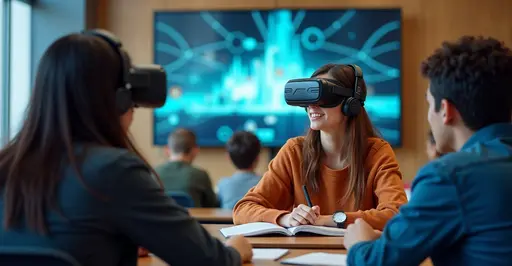
The Virtual Revolution in Education
Education startups are transforming remote learning through fully immersive VR classrooms. Companies like Labster are leading this shift by creating interactive virtual laboratories where STEM students conduct experiments in physics, chemistry, and biology. The technology uses specialized headsets and motion controllers to simulate real classroom environments, allowing students to manipulate 3D objects and collaborate with peers in virtual spaces.
How VR Classrooms Work
These platforms create school environments where students:
- Attend live lectures in virtual amphitheaters
- Conduct science experiments in simulated labs
- Collaborate on projects in interactive workspaces
- Take field trips to historical sites or ecosystems
A PwC study shows VR learners are 150% more engaged and absorb information 400% faster than traditional online methods. Teachers can monitor student progress through analytics dashboards that track participation and comprehension.
Benefits Beyond Engagement
Beyond making learning fun, VR solves critical educational challenges:
Accessibility Advancements
Students in remote areas gain access to laboratory equipment they couldn't otherwise use. Those with mobility challenges can participate in physical activities through avatars. Language learners practice conversations with AI-powered virtual native speakers.
Cost Efficiency
Schools save significantly on physical infrastructure. A single VR chemistry lab setup replaces expensive consumables and hazardous material disposal. Field trips become affordable virtual experiences – students can explore coral reefs or space stations without leaving campus.
Startups Driving Innovation
New education technology companies are emerging with specialized solutions:
| Startup | Specialization | Unique Feature |
|---|---|---|
| Labster | Science Labs | 200+ biology/chemistry simulations |
| Prisma | Hybrid Schooling | Live instructor + AI tutors |
| Mursion | Teacher Training | VR classroom management simulations |
| ENGAGE | Virtual Campus | Multi-user university environments |
Investment in edtech VR surged to $3.2 billion in 2024, with projections showing 45% annual growth through 2027 according to market analysis.
Overcoming Challenges
Despite progress, significant hurdles remain:
- Hardware costs: High-end VR headsets remain expensive for some schools
- Motion sickness: 10-15% of users experience discomfort during extended use
- Content gaps: Limited curriculum for humanities and social sciences
Startups are addressing these through:
- Phone-based VR alternatives requiring only $15 cardboard viewers
- Improved motion compensation algorithms
- AI-assisted content creation tools for teachers
The Future Classroom
Education experts predict VR will evolve beyond supplemental use to become core infrastructure. Upcoming developments include:
- Haptic feedback suits allowing students to "feel" virtual objects
- Emotion recognition for personalized learning adjustments
- Blockchain-secured digital credentialing
As Meta's Education Lead stated: "We're not just building new tools – we're redefining what 'school' means for the digital generation."

 Nederlands
Nederlands
 English
English
 French
French
 Deutsch
Deutsch
 Espaniol
Espaniol
 Portugese
Portugese



